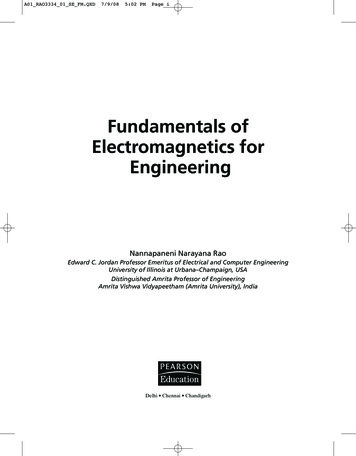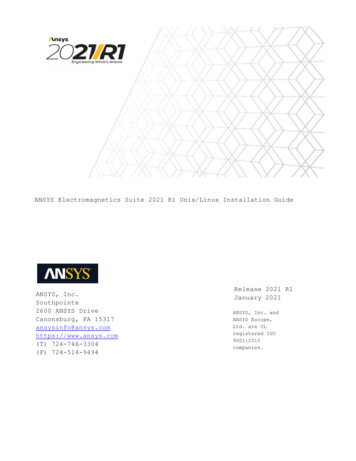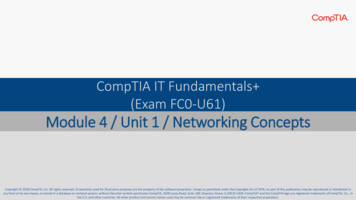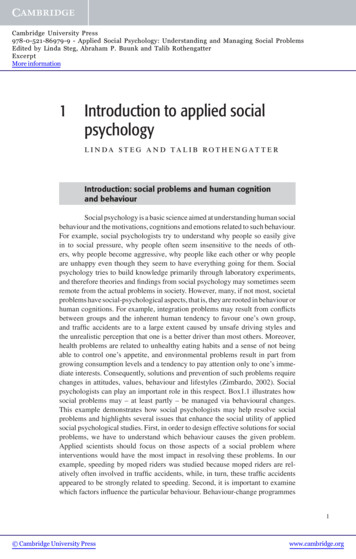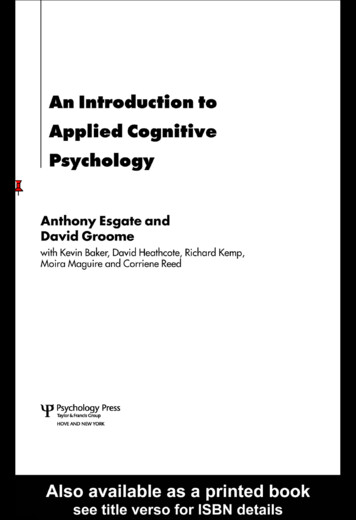
Transcription
Fundamentals of Applied Electromagnetics 6ebyFawwaz T. Ulaby, Eric Michielssen, and Umberto RavaioliExercise SolutionsFawwaz T. Ulaby, Eric Michielssen, and Umberto Ravaioli, Fundamentals of Applied Electromagneticsc 2010 Prentice Hall
ChaptersChapter 1 Introduction: Waves and PhasorsChapter 2 Transmission LinesChapter 3 Vector AnalysisChapter 4 ElectrostaticsChapter 5 MagnetostaticsChapter 6 Maxwell’s Equations for Time-Varying FieldsChapter 7 Plane-Wave PropagationChapter 8 Wave Reflection and TransmissionChapter 9 Radiation and AntennasChapter 10 Satellite Communication Systems and Radar SensorsFawwaz T. Ulaby, Eric Michielssen, and Umberto Ravaioli, Fundamentals of Applied Electromagneticsc 2010 Prentice Hall
Chapter 1 Exercise SolutionsExercise 1.1Exercise 1.2Exercise 1.3Exercise 1.4Exercise 1.5Exercise 1.6Exercise 1.7Exercise 1.8Exercise 1.9Exercise 1.10Fawwaz T. Ulaby, Eric Michielssen, and Umberto Ravaioli, Fundamentals of Applied Electromagneticsc 2010 Prentice Hall
Exercise 1.1Consider the red wave shown in Fig. E1.1. What is the wave’s (a) amplitude, (b) wavelength, and (c)frequency, given that its phase velocity is 6 m/s?Solution:(a) A 6 V.(b) λ 4 cm.(c) f up6 150 Hz.λ4 10 2Fawwaz T. Ulaby, Eric Michielssen, and Umberto Ravaioli, Fundamentals of Applied Electromagneticsc 2010 Prentice Hall
Exercise 1.2The wave shown in red in Fig. E1.2 is given by υ 5 cos 2πt/8. Of the following four equations:(1) υ 5 cos(2πt/8 π/4),(2) υ 5 cos(2πt/8 π/4),(3) υ 5 cos(2πt/8 π/4),(4) υ 5 sin 2πt/8,(a) which equation applies to the green wave? (b) which equation applies to the blue wave?Solution:(a) The green wave has an amplitude of 5 V and a period T 8 s. Its peak occurs earlier than that of the red wave; hence,its constant phase angle is positive relative to that of the red wave. A full cycle of 8 s corresponds to 2π in phase. The greenwave crosses the time axis 1 s sooner than the red wave. Hence, its phase angle isφ0 1π 2π .84Consequently,υ 5 cos(2πt/T φ0 ) 5 cos(2πt/7 π/4),which is given by #2.(b) The blue wave’s period T 8 s. Its phase angle is delayed relative to the red wave by 2 s. Hence, the phase angle isnegative and given by2πφ0 2π ,82and 2πt πυ 5 cos 82 5 sin 2πt/8,which is given by #4.Fawwaz T. Ulaby, Eric Michielssen, and Umberto Ravaioli, Fundamentals of Applied Electromagneticsc 2010 Prentice Hall
Exercise 1.3The electric field of a traveling electromagnetic wave is given byE(z,t) 10 cos(π 107t πz/15 π/6) (V/m).Determine (a) the direction of wave propagation, (b) the wave frequency f , (c) its wavelength λ , and (d) its phase velocity up .Solution:(a) z-direction because the signs of the coefficients of t and z are both positive.(b) From the given expression,ω π 107(rad/s).Hence,f ωπ 107 5 106 Hz 5 MHz.2π2π(c) From the given expression,π2π .λ15Hence λ 30 m.(d) up f λ 5 106 30 1.5 108 m/s.Fawwaz T. Ulaby, Eric Michielssen, and Umberto Ravaioli, Fundamentals of Applied Electromagneticsc 2010 Prentice Hall
Exercise 1.4 Consider the red wave shown in Fig. E1.4. What is the wave’s (a) amplitude (at x 0), (b) wavelength, and(c) attenuation constant?Solution: The wave shown in the figure exhibits a sinusoidal variation in x and its amplitude decreases as a function of x.Hence, it can be described by the general expression 2πx αxυ Aecos φ0 .λFrom the given coordinates of the first two peaks, we deduce thatλ 8.4 2.8 5.6 cm.At x 0, υ 5 V and it occurs exactly λ /2 before the first peak. Hence, the wave amplitude is 5 V, and from 5 5 cos(0 φ0 ),it follows thatφ0 π.Consequently,υ 5e αx 2πxcos π .5.6In view of the relation cos x cos(x π), υ can be expressed asυ 5e αx cos2πx5.6(V).We can describe the amplitude as 5 V for a wave with a constant phase angle of π, or as 5 V with a phase angle of zero.At x 2.8 cm, 2π 2.8υ(x 2.8) 4.23 5e 2.8α cos5.6 5e 2.8α .Fawwaz T. Ulaby, Eric Michielssen, and Umberto Ravaioli, Fundamentals of Applied Electromagneticsc 2010 Prentice Hall
Hence,e 2.8α and4.23,5 14.23α ln 0.06 Np/cm.2.85Fawwaz T. Ulaby, Eric Michielssen, and Umberto Ravaioli, Fundamentals of Applied Electromagneticsc 2010 Prentice Hall
Exercise 1.5The red wave shown in Fig. E1.5 is given by υ 5 cos 4πx (V). What expression is applicable to (a) theblue wave and (b) the green wave?Solution: At x 0, all three waves start at their peak value of 5 V. Also, λ 0.5 m for all three waves. Hence, they sharethe general form2πxλ 5e αx cos 4πx (V).υ Ae αx cosFor the red wave, α 0.For the blue wave,3.52 5e 0.5αα 0.7 Np/m.1.01 5e 0.5αα 3.2 Np/m.For the green wave,Fawwaz T. Ulaby, Eric Michielssen, and Umberto Ravaioli, Fundamentals of Applied Electromagneticsc 2010 Prentice Hall
Exercise 1.6An electromagnetic wave is propagating in the z-direction in a lossy medium with attenuation constantα 0.5 Np/m. If the wave’s electric-field amplitude is 100 V/m at z 0, how far can the wave travel before its amplitudewill have been reduced to (a) 10 V/m, (b) 1 V/m, (c) 1 µV/m?Solution:(a)100e αz 10100e 0.5z 10e 0.5z 0.1 0.5z ln 0.1 2.3z 4.6 m.(b)100e 0.5z 1ln 0.01z 9.2 m. 0.5(c)100e 0.5z 10 6z ln 10 8 37 m. 0.5Fawwaz T. Ulaby, Eric Michielssen, and Umberto Ravaioli, Fundamentals of Applied Electromagneticsc 2010 Prentice Hall
Exercise 1.7Express the following complex functions in polar form:z1 (4 j3)2 ,z2 (4 j3)1/2 .Solution:z1 (4 j3)2hi2 1 (42 32 )1/2 tan 3/4 [5 36.87 ]2 25 73.7 .z2 (4 j3)1/2hi1/2 1 (42 32 )1/2 j tan 3/4 [5 36.87 ]1/2 5 18.4 .Fawwaz T. Ulaby, Eric Michielssen, and Umberto Ravaioli, Fundamentals of Applied Electromagneticsc 2010 Prentice Hall
Exercise 1.8Show that 2 j (1 j).Solution:e jπ/2 0 j sin(π/2) j p2 j [2e jπ/2 ]1/2 2 e jπ/4 2(cos π/4 j sin π/4) 11 2 j22 (1 j).Fawwaz T. Ulaby, Eric Michielssen, and Umberto Ravaioli, Fundamentals of Applied Electromagneticsc 2010 Prentice Hall
Exercise 1.9A series RL circuit is connected to a voltage source given by vs (t) 150 cos ωt (V). Find (a) the phasorcurrent I and (b) the instantaneous current i(t) for R 400 Ω, L 3 mH, and ω 105 rad/s.Solution:(a) From Example 1–4,I VesR jωL150400 j105 3 10 3150 0.3 36.9 400 j300 (A).(b)e jωt ]i(t) Re[Ie 5 Re[0.3e j36.9 e j10 t ] 0.3 cos(105t 36.9 ) (A).Fawwaz T. Ulaby, Eric Michielssen, and Umberto Ravaioli, Fundamentals of Applied Electromagneticsc 2010 Prentice Hall
Exercise 1.10A phasor voltage is given by Ve j5 V. Find v(t).Solution:Ve j5 5e jπ/2v(t) Re[Ve e jωt ] Re[5e jπ/2 e jωt ] π 5 sin ω 5 cos ωt 2(V).Fawwaz T. Ulaby, Eric Michielssen, and Umberto Ravaioli, Fundamentals of Applied Electromagneticsc 2010 Prentice Hall
Chapter 2 Exercise SolutionsExercise 2.1Exercise 2.2Exercise 2.3Exercise 2.4Exercise 2.5Exercise 2.6Exercise 2.7Exercise 2.8Exercise 2.9Exercise 2.10Exercise 2.11Exercise 2.12Exercise 2.13Exercise 2.14Exercise 2.15Exercise 2.16Exercise 2.17Fawwaz T. Ulaby, Eric Michielssen, and Umberto Ravaioli, Fundamentals of Applied Electromagneticsc 2010 Prentice Hall
Exercise 2.1 Use Table 2-1 to compute the line parameters of a two-wire air line whose wires are separated by a distanceof 2 cm, and each is 1 mm in radius. The wires may be treated as perfect conductors with σc .Solution: Two-wire air line: Because medium between wires is air, ε ε0 , µ µ0 and σ 0.d 2 cm, 1/2π f µc 0Rs σca 1 mm,σc R0 0 s 2µ0 ddL0 ln 1 π2a2a s 2 7204π 1020 ln 1 π22 4 10 7 ln[10 99] 1.2 (µH/m).G0 0C0 because σ 0 lnπε0 qd2a d 2 12a π 8.85 10 12 9.29ln[10 99](pF/m).Fawwaz T. Ulaby, Eric Michielssen, and Umberto Ravaioli, Fundamentals of Applied Electromagneticsc 2010 Prentice Hall
Exercise 2.2Calculate the transmission line parameters at 1 MHz for a rigid coaxial air line with an inner conductordiameter of 0.6 cm and an outer conductor diameter of 1.2 cm. The conductors are made of copper [see Appendix B for µcand σc of copper].Solution: Coaxial air line: Because medium between wires is air, ε ε0 , µ µ0 and σ 0.a 0.3 cm,Rs b 0.6 cm,µc µ0 ,σc 5.8 107 S/mpπ f µc /σc [π 106 4π 10 7 /(5.8 107 )]1/2 2.6 10 4 Ω.RsR 2π0 1 1 a b 2.6 10 4 2π 11 33 106 10 3 µ0b4π 10 7L ln ln 2 0.142πa2π0G0 0C0 2.08 10 2(Ω/m)(µH/m)because σ 02πε2π 8.85 10 12 80.3ln(b/a)ln 2(pF/m).Fawwaz T. Ulaby, Eric Michielssen, and Umberto Ravaioli, Fundamentals of Applied Electromagneticsc 2010 Prentice Hall
Exercise 2.3Verify that Eq. (2.26a) is indeed a solution of the wave equation given by Eq. (2.21).Solution:Ve (z) V0 e γz V0 eγzd 2 Ve (z)? γ 2 Ve (z) 02dzd 2 γz?(V0 e V0 eγz ) γ 2 (V0 e γz V0 eγz ) 02dzγ 2V0 e γz γ 2V0 eγz γ 2V0 e γz γ 2V0 eγz 0.Fawwaz T. Ulaby, Eric Michielssen, and Umberto Ravaioli, Fundamentals of Applied Electromagneticsc 2010 Prentice Hall
Exercise 2.4A two-wire air line has the following line parameters: R0 0.404 (mΩ/m), L0 2.0 (µH/m), G0 0, and0C 5.56 (pF/m). For operation at 5 kHz, determine (a) the attenuation constant α, (b) the phase constant β , (c) the phasevelocity up , and (d) the characteristic impedance Z0 .Solution: Given:R0 0.404 (mΩ/m),G0 0,L0 2.0 (µH/m),C0 5.56 (pF/m).(a)noα Re [(R0 jωL0 )(G0 jωC0 )]1/2no Re [(0.404 10 3 j2π 5 103 2 10 6 )(0 j2π 5 103 5.56 10 12 )]1/2 Re[3.37 10 7 j1.05 10 4 ]α 3.37 10 7(Np/m).(b) From part (a),noβ Im [(R0 jωL0 )(G0 jωC0 )]1/2 1.05 10 4(rad/m).(c)up ω2π 5 103 3 108β1.05 10 4(m/s).(d)R0 jωL0α jβ0.404 10 3 j5 103 2 10 6 3.37 10 7 j1.05 10 4 (600 j2) Ω.Z0 Fawwaz T. Ulaby, Eric Michielssen, and Umberto Ravaioli, Fundamentals of Applied Electromagneticsc 2010 Prentice Hall
Exercise 2.5For a lossless transmission line, λ 20.7 cm at 1 GHz. Find εr of the insulating material.Solution:λ0λ εr 2 2 2λ0c3 108εr 2.1.λfλ1 108 20.7 10 2Fawwaz T. Ulaby, Eric Michielssen, and Umberto Ravaioli, Fundamentals of Applied Electromagneticsc 2010 Prentice Hall
Exercise 2.6 A lossless transmission line uses a dielectric insulating material with εr 4. If its line capacitance is C 0 10(pF/m), find (a) the phase velocity up , (b) the line inductance L0 , and (c) the characteristic impedance Z0 .Solution:(a)c3 108up 1.5 108 m/s.εr4(b)1up ,L0C0L0 u2p 1.L0C011 4.45u2pC0 (1.5 108 )2 10 10 12(µH/m).(c)rZ0 L0 C0 4.45 10 610 10 12 1/2 667.1 Ω.Fawwaz T. Ulaby, Eric Michielssen, and Umberto Ravaioli, Fundamentals of Applied Electromagneticsc 2010 Prentice Hall
Exercise 2.7A 50-Ω lossless transmission line is terminated in a load impedance ZL (30 j200) Ω. Calculate thevoltage reflection coefficient at the load.Solution:ZL Z0ZL Z030 j200 50 20 j200 0.93 27.5 .(30 j200) 5080 j200Γ Fawwaz T. Ulaby, Eric Michielssen, and Umberto Ravaioli, Fundamentals of Applied Electromagneticsc 2010 Prentice Hall
Exercise 2.8A 150-Ω lossless line is terminated in a capacitor whose impedance is ZL j30 Ω. Calculate Γ.Solution:ZL Z0ZL Z0 j30 150 1 157.4 . j30 150Γ Fawwaz T. Ulaby, Eric Michielssen, and Umberto Ravaioli, Fundamentals of Applied Electromagneticsc 2010 Prentice Hall
Exercise 2.9 Use CD Module 2.4 to generate the voltage and current standing-wave patterns for a 50-Ω line of length 1.5λ ,terminated in an inductance with ZL j140 Ω.Solution: Standing-wave patterns generated with the help of DVD Module 2.4 are shown.Fawwaz T. Ulaby, Eric Michielssen, and Umberto Ravaioli, Fundamentals of Applied Electromagneticsc 2010 Prentice Hall
Exercise 2.10load.If Γ 0.5 60 and λ 24 cm, find the locations of the voltage maximum and minimum nearest to theSolution:Γ 0.5 60 ,λ 24 cmθr λ λ (because θr is negative)2 4π ( π/3) 24 24 cm [ 2 12] cm 10 cm. 4π2lmax λlmin lmax (because lmax λ /4)4 24 10 cm 4 cm.4Fawwaz T. Ulaby, Eric Michielssen, and Umberto Ravaioli, Fundamentals of Applied Electromagneticsc 2010 Prentice Hall
Exercise 2.11A 140-Ω lossless line is terminated in a load impedance ZL (280 j182) Ω. If λ 72 cm, find (a) thereflection coefficient Γ, (b) the voltage standing-wave ratio S, (c) the locations of voltage maxima, and (d) the locations ofvoltage minima.Solution:Z0 140 Ω,ZL (280 j182) Ω(a)ZL Z0ZL Z0280 j182 140 140 j182 0.5 29 .280 j182 140 420 j182Γ (b)S 1 Γ 1 0.5 1.5 3.1 Γ 1 0.5 0.5(c)θr λ nλ ,n 0, 1, 2, . . .4π2(29π/180) 0.72 n 0.72 4π2 (2.9 36n) (cm),n 0, 1, 2, . . .lmax (d)λlmin lmax 4 72cm (2.9 36n) 4 (20.9 36n) cm,n 0, 1, 2, . . .Fawwaz T. Ulaby, Eric Michielssen, and Umberto Ravaioli, Fundamentals of Applied Electromagneticsc 2010 Prentice Hall
Exercise 2.12A 50-Ω lossless transmission line uses an insulating material with εr 2.25. When terminated in an opencircuit, how long should the line be for its input impedance to be equivalent to a 10-pF capacitor at 50 MHz?Solution: For a 10-pF capacitor at 50 MHz,11000 j j Ω6 12jωC 2π 50 10 10 10π 2π εr 2π f εr2π β λλ0c 2π 5 107 2.25 1.57 (rad/m).3 108Zc For lossless lines with open-circuit termination,Zin jZ0 cot β l j50 cot 1.57lHence, j1000 j50 cot 1.57lπorl 9.92(cm).Fawwaz T. Ulaby, Eric Michielssen, and Umberto Ravaioli, Fundamentals of Applied Electromagneticsc 2010 Prentice Hall
Exercise 2.13 A 300-Ω feedline is to be connected to a 3-m long, 150-Ω line terminated in a 150-Ω resistor. Both lines arelossless and use air as the insulating material, and the operating frequency is 50 MHz. Determine (a) the input impedance ofthe 3-m long line, (b) the voltage standing-wave ratio on the feedline, and (c) the characteristic impedance of a quarter-wavetransformer were it to be used between the two lines in order to achieve S 1 on the feedline.Solution: At 50 MHz,λ λ0 c3 108 6 m.f5 107(a)l3 0.5.λ6Hence, Zin ZL 150 Ω. (Zin ZL if Z nλ /2.)(b)Zin Z0 150 300 1501 .Zin Z0 150 30045034/31 Γ 1 31 2.S 11 Γ 1 32/3Γ (c)2Z02 Z1 Z3 300 150 45, 000Z02 212.1 Ω.where Z1 is the feedline and Z3 is Zin of part (a).Fawwaz T. Ulaby, Eric Michielssen, and Umberto Ravaioli, Fundamentals of Applied Electromagneticsc 2010 Prentice Hall
Exercise 2.14For a 50-Ω lossless transmission line terminated in a load impedance ZL (100 j50) Ω, determine thefraction of the average incident power reflected by the load.Solution:ZL Z0ZL Z0100 j50 5050 j50 0.45 26.6 .100 j50 50 150 j50Γ Fraction of reflected power Γ 2 (0.45)2 20%.Fawwaz T. Ulaby, Eric Michielssen, and Umberto Ravaioli, Fundamentals of Applied Electromagneticsc 2010 Prentice Hall
Exercise 2.15For the line of Exercise 2.14, what is the magnitude of the average reflected power if V0 1 V?Solution:rPav Γ 2 V0 2 0.2 1 22Z02 50(mW).Fawwaz T. Ulaby, Eric Michielssen, and Umberto Ravaioli, Fundamentals of Applied Electromagneticsc 2010 Prentice Hall
Exercise 2.16Use the Smith chart to find the values of Γ corresponding to the following normalized load impedances:(a) zL 2 j0, (b) zL 1 j1, (c) zL 0.5 j2, (d) zL j3, (e) zL 0 (short circuit), (f) zL (open circuit), (g) zL 1(matched load).Solution:(a)Γ OA θ 1 0.33OR(b)Γ OB θ 2 0.45 63.4 ORΓ OC θ 3 0.83 50.9 OR(c)(d)Γ OD θ 4 1 36.9 ORFawwaz T. Ulaby, Eric Michielssen, and Umberto Ravaioli, Fundamentals of Applied Electromagneticsc 2010 Prentice Hall
(e)Γ OE θ 5 1 180 1OR(f)Γ OF θ 1 1OR(g)Γ OG 0ORFawwaz T. Ulaby, Eric Michielssen, and Umberto Ravaioli, Fundamentals of Applied Electromagneticsc 2010 Prentice Hall
Exercise 2.17Use the Smith chart to find the normalized input impedance of a lossless line of length l terminated in anormalized load impedance zL for each of the following combinations: (a) l 0.25λ , zL 1 j0, (b) l 0.5λ , zL 1 j1,(c) l 0.3λ , zL 1 j1, (d) l 1.2λ , zL 0.5 j0.5, (e) l 0.1λ , zL 0 (short circuit), (f) l 0.4λ , zL j3, (g) l 0.2λ ,zL (open circuit).Solution:(a)zin 1 j0Fawwaz T. Ulaby, Eric Michielssen, and Umberto Ravaioli, Fundamentals of Applied Electromagneticsc 2010 Prentice Hall
(b)zin 1 j1Fawwaz T. Ulaby, Eric Michielssen, and Umberto Ravaioli, Fundamentals of Applied Electromagneticsc 2010 Prentice Hall
(c)zin 0.76 j0.84Fawwaz T. Ulaby, Eric Michielssen, and Umberto Ravaioli, Fundamentals of Applied Electromagneticsc 2010 Prentice Hall
(d)zin 0.59 j0.66Fawwaz T. Ulaby, Eric Michielssen, and Umberto Ravaioli, Fundamentals of Applied Electromagneticsc 2010 Prentice Hall
(e)zin 0 j0.73Fawwaz T. Ulaby, Eric Michielssen, and Umberto Ravaioli, Fundamentals of Applied Electromagneticsc 2010 Prentice Hall
(f)zin 0 j0.72Fawwaz T. Ulaby, Eric Michielssen, and Umberto Ravaioli, Fundamentals of Applied Electromagneticsc 2010 Prentice Hall
(g)zin 0 j0.32Fawwaz T. Ulaby, Eric Michielssen, and Umberto Ravaioli, Fundamentals of Applied Electromagneticsc 2010 Prentice Hall
Chapter 3 Exercise SolutionsExercise 3.1Exercise 3.2Exercise 3.3Exercise 3.4Exercise 3.5Exercise 3.6Exercise 3.7Exercise 3.8Exercise 3.9Exercise 3.10Exercise 3.11Exercise 3.12Exercise 3.13Exercise 3.14Exercise 3.15Exercise 3.16Exercise 3.17Exercise 3.18Exercise 3.19Fawwaz T. Ulaby, Eric Michielssen, and Umberto Ravaioli, Fundamentals of Applied Electromagneticsc 2010 Prentice Hall
Exercise 3.1Find the distance vector between P1 (1, 2, 3) and P2 ( 1, 2, 3) in Cartesian coordinates.Solution: P1 P2 x̂(x2 x1 ) ŷ(y2 y1 ) ẑ(z2 z1 ) x̂( 1 1) ŷ( 2 2) ẑ(3 3) x̂2 ŷ4.Fawwaz T. Ulaby, Eric Michielssen, and Umberto Ravaioli, Fundamentals of Applied Electromagneticsc 2010 Prentice Hall
Exercise 3.2Find the angle θ between vectors A and B of Example 3-1 using the cross product between them.Solution: B n̂AB sin θABA B A AB ( x̂ ŷ5 ẑ) (x̂2 ŷ3 ẑ3) 22 27 ẑ10 ŷ2 ẑ3 x̂3 ŷ3 x̂15 22 27 x̂12 ŷ ẑ7 144 1 49 0.5722 2722 27sin θAB θAB sin 1 (0.57) 34.9 or 145.1 .Fawwaz T. Ulaby, Eric Michielssen, and Umberto Ravaioli, Fundamentals of Applied Electromagneticsc 2010 Prentice Hall
Exercise 3.3Find the angle that vector B of Example 3-1 makes with the z-axis.Solution:B · ẑ B cos θ ( x̂ ŷ5 ẑ) · ẑ 27 cos θ 1cos θ 27θ 101.1 .Fawwaz T. Ulaby, Eric Michielssen, and Umberto Ravaioli, Fundamentals of Applied Electromagneticsc 2010 Prentice Hall
Exercise 3.4 Vectors A and B lie in the y-z plane and both have the same magnitude of 2 (Fig. E3.4). Determine (a) A · B B.and (b) A Solution:(a)A · B AB cos(90 30 ) 2 2 cos 120 2.(b)A ŷ 2B ŷ 2 cos 60 ẑ 2 cos 30 ŷ 1 ẑ 1.73 B ŷ 2 ( ŷ 1 ẑ 1.73)A x̂ 3.46.Fawwaz T. Ulaby, Eric Michielssen, and Umberto Ravaioli, Fundamentals of Applied Electromagneticsc 2010 Prentice Hall
Exercise 3.5If A · B A · C, does it follow that B C?Solution: The answer is No, which can be demonstrated through the following example. LetA x̂ 1,B x̂ 2 ŷ 1,C x̂ 2 ŷ 2.A · B 2,A · C 2,butB 6 C.Fawwaz T. Ulaby, Eric Michielssen, and Umberto Ravaioli, Fundamentals of Applied Electromagneticsc 2010 Prentice Hall
Exercise 3.6A circular cylinder of radius r 5 cm is concentric with the z-axis and extends between z 3 cm andz 3 cm. Use Eq. (3.44) to find the cylinder’s volume.Solution:d V r dr dφ dzZ 5 cm Z 2π Z 3 cmV r dr dφ dzr 0φ 0 z 3 cm5 cm2r3 cm φ 2π0 z 3 cm2 025 2π 6 471.2 cm3 .2Fawwaz T. Ulaby, Eric Michielssen, and Umberto Ravaioli, Fundamentals of Applied Electromagneticsc 2010 Prentice Hall
Exercise 3.7 Point P (2 3, π/3, 2) is given in cylindrical coordinates. Express P in spherical coordinates.Solution:q p r2 z2 (2 3)2 ( 2)2 4πφ (unchanged)3 ! π2π 1 r 1 2 3 60 orθ tan tan.z 233R Fawwaz T. Ulaby, Eric Michielssen, and Umberto Ravaioli, Fundamentals of Applied Electromagneticsc 2010 Prentice Hall
Exercise 3.8Transform vectorA x̂(x y) ŷ(y x) ẑzfrom Cartesian to cylindrical coordinates.Solution:A x̂(x y) ŷ(y x) ẑz (r̂ cos φ φ̂φ sin φ )(r cos φ r sin φ ) (r̂ sin φ φ̂φ cos φ )(r sin φ r cos φ ) ẑz r̂(cos2 φ cos φ sin φ sin2 φ cos φ sin φ )r φ̂φ ( sin φ cos φ sin2 φ sin φ cos φ cos2 φ )r ẑz r̂r φ̂φ r ẑz.Fawwaz T. Ulaby, Eric Michielssen, and Umberto Ravaioli, Fundamentals of Applied Electromagneticsc 2010 Prentice Hall
Exercise 3.9Given V x2 y xy2 xz2 , (a) find the gradient of V , and (b) evaluate it at (1, 1, 2).Solution:V x2 y xy2 xz2(a) V V V ŷ ẑ x y z22 x̂ (2xy y z ) ŷ (x2 2xy) ẑ 2xz. V x̂(b) V (1, 1,2) x̂ ( 2 1 4) ŷ (1 2) ẑ 4 x̂ 3 ŷ ẑ 4.Fawwaz T. Ulaby, Eric Michielssen, and Umberto Ravaioli, Fundamentals of Applied Electromagneticsc 2010 Prentice Hall
Exercise 3.10Find the directional derivative of V rz2 cos 2φ along the direction A r̂2 ẑ and evaluate it at (1, π/2, 2).Solution:V rz2 cos 2φ1 V V V φ̂φ ẑ V r̂ rr φ z2r r̂ z2 cos 2φ φ̂φ z2 sin 2φ ẑ 2rz cos 2φrdV V · âldlA V ·Ar̂ 2 ẑ (r̂ z2 cos 2φ φ̂φ 2z2 sin 2φ ẑ 2rz cos 2φ ) · 52z2 cos 2φ 2rz cos 2φ 5dVdl2 4 cos π 2 2 cos π 5(1,π/2,2) 4/ 5. Fawwaz T. Ulaby, Eric Michielssen, and Umberto Ravaioli, Fundamentals of Applied Electromagneticsc 2010 Prentice Hall
Exercise 3.11The power density radiated by a star [Fig. E3.11(a)] decreases radially as S(R) S0 /R2 , where R is theradial distance from the star and S0 is a constant. Recalling that the gradient of a scalar function denotes the maximum rateof change of that function per unit distance and the direction of the gradient is along the direction of maximum increase,generate an arrow representation of S.Solution:S(R) S0.R2 1 1 θ̂θ φ̂φ RR θR sin θ φS0 R̂ 2 3 .R S R̂ S0R2Fawwaz T. Ulaby, Eric Michielssen, and Umberto Ravaioli, Fundamentals of Applied Electromagneticsc 2010 Prentice Hall
Exercise 3.12The graph in Fig. E3.12(a) depicts a gentle change in atmospheric temperature from T1 over the sea to T2over land. The temperature profile is described by the functionT (x) T1 (T2 T1 )/(e x 1),where x is measured in kilometers and x 0 is the sea-land boundary. (a) In which direction does T point and (b) at whatvalue of x is it a maximum?Solution:T (x) T1 T2 T1e x 1 T x T2 T1 x̂T1 x xe 1 x x̂(T2 T1 )(e 1) 1 x x̂(T2 T1 )e x (e x 1) 2 T x̂ x̂e x (T2 T1 ).(e x 1)2Fawwaz T. Ulaby, Eric Michielssen, and Umberto Ravaioli, Fundamentals of Applied Electromagneticsc 2010 Prentice Hall
Exercise 3.13Given A e 2y (x̂ sin 2x ŷ cos 2x), find · A.Solution:A e 2y (x̂ sin 2x ŷ cos 2x) Ax Ay Az ·A x y z 2y (e sin 2x) (e 2y cos 2x) x y 2y 2y 2e cos 2x 2e cos 2x 0.Fawwaz T. Ulaby, Eric Michielssen, and Umberto Ravaioli, Fundamentals of Applied Electromagneticsc 2010 Prentice Hall
Exercise 3.14Given A r̂ r cos φ φ̂φ r sin φ ẑ 3z, find · A at (2, 0, 3).Solution:A r̂ r cos φ φ̂φ r sin φ ẑ 3z1 Aφ Az1 (rAr ) ·A r rr φ z1 21 (r cos φ ) (r sin φ ) (3z)r rr φ z 2 cos φ cos φ 3 · A (2,0,3) 2 1 3 6.Fawwaz T. Ulaby, Eric Michielssen, and Umberto Ravaioli, Fundamentals of Applied Electromagneticsc 2010 Prentice Hall
Exercise 3.15at the origin.If E R̂AR in spherical coordinates, calculate the flux of E through a spherical surface of radius a, centeredSolution:E R̂ARZE · ds Z π Z 2πnSθ 0 φ 0R̂AR · R̂R2 sin θ dθ dφ R ahiπ 2πAR3 cos θ 0R a 4πAa3 .Fawwaz T. Ulaby, Eric Michielssen, and Umberto Ravaioli, Fundamentals of Applied Electromagneticsc 2010 Prentice Hall
Exercise 3.16 Verify the divergence theorem by calculating the volume integral of the divergence of the field E of Exercise3.11 over the volume bounded by the surface of radius a.Solution:ZDivergence Theorem:From Exercise 3.11,ZV · E dV ZE · dsnSE · ds 4πAa3 .nSFor the left side of Divergence Theorem, with E R̂AR, ·E ZV1 1 (R2 ER ) 2(AR3 ) 3AR2 RR R · E dV Z a Z π Z 2π3A · R2 sin θ dR dθ dφ0 00a33AR ( cos θ π0 ) π 2π0303 4πAa .Hence, Divergence Theorem is verified.Fawwaz T. Ulaby, Eric Michielssen, and Umberto Ravaioli, Fundamentals of Applied Electromagneticsc 2010 Prentice Hall
Exercise 3.17The arrow representation in Fig. E3.17 represents the vector field A x̂ x ŷ y. At a given point in space,A has a positive divergence · A if the net flux flowing outward through the surface of an imaginary infinitesimal volumecentered at that point is positive, · A is negative if the net flux is into the volume, and · A 0 if the same amount of fluxenters into the volume as leaves it. Determine · A everywhere in the x–y plane.Solution:A x̂ x ŷ y Ax Ay Az ·A x y z x y x y 1 1 0.Fawwaz T. Ulaby, Eric Michielssen, and Umberto Ravaioli, Fundamentals of Applied Electromagneticsc 2010 Prentice Hall
Exercise 3.18 A at (2, 0, 3) in cylindrical coordinates for the vector fieldFind A r̂10e 2r cos φ ẑ10 sin φ .Solution:A r̂10e 2r cos φ ẑ10 sin φ 1 Az Aφ Ar Az1 Ar A r̂ φ̂φ ẑrAφ r φ z z rr r φ 1 2r(10 sin φ ) φ̂φ(10e cos φ ) (10 sin φ ) r̂r φ z r1 ẑ( 10e 2r cos φ )r φ10e 2r10 cos φ ẑsin φ r̂rr A (2,0,3) r̂ 5.Fawwaz T. Ulaby, Eric Michielssen, and Umberto Ravaioli, Fundamentals of Applied Electromagneticsc 2010 Prentice Hall
Exercise 3.19 A at (3, π/6, 0) in spherical coordinates for the vector field A θ̂θ 12 sin θ .Find Solution:A θ̂θ 12 sin θ1 (RAθ ) A φ̂φR R1 φ̂φ(12R sin θ )R R12 sin θ φ̂φ.R A (3,π/6,0) φ̂φ 4 sin 30 φ̂φ 2.Fawwaz T. Ulaby, Eric Michielssen, and Umberto Ravaioli, Fundamentals of Applied Electromagneticsc 2010 Prentice Hall
Chapter 4 Exercise SolutionsExercise 4.1Exercise 4.2Exercise 4.3Exercise 4.4Exercise 4.5Exercise 4.6Exercise 4.7Exercise 4.8Exercise 4.9Exercise 4.10Exercise 4.11Exercise 4.12Exercise 4.13Exercise 4.14Exercise 4.15Exercise 4.16Exercise 4.17Exercise 4.18Exercise 4.19Fawwaz T. Ulaby, Eric Michielssen, and Umberto Ravaioli, Fundamentals of Applied Electromagneticsc 2010 Prentice Hall
Exercise 4.1A square plate in the x–y plane is situated in the space defined by 3 m x 3 m and 3 m y 3 m.Find the total charge on the plate if the surface charge density is given by ρs 4y2 (µC/m2 ).Solution:ρs 4y2ZQ Sρs dsZ 3Z 3 4y2 dx dy 3 34y3 x 333 432 µC 0.432(mC). 3 3Fawwaz T. Ulaby, Eric Michielssen, and Umberto Ravaioli, Fundamentals of Applied Electromagneticsc 2010 Prentice Hall
Exercise 4.2A spherical shell centered at the origin extends between R 2 cm and R 3 cm. If the volume chargedensity is given by ρv 3R 10 4 (C/m3 ), find the total charge contained in the shell.Solution:ρv 3R 10 4ZQ ρv d VVZ 3 cm Z πZ 2π3R 10 4 · R2 sin θ dR dθ dφ R 2 cm θ 0 φ 03 cm3R4 44 10 2 2π2 cm 3π 10 4 (3 10 2 )4 (2 10 2 )4 0.61(nC).Fawwaz T. Ulaby, Eric Michielssen, and Umberto Ravaioli, Fundamentals of Applied Electromagneticsc 2010 Prentice Hall
Exercise 4.3 Four charges of 10 µC each are located in free space at points with Cartesian coordinates ( 3, 0, 0), (3, 0, 0),(0, 3, 0), and (0, 3, 0). Find the force on a 20-µC charge located at (0, 0, 4). All distances are in meters.Solution:R1 x̂ 3R2 x̂ 3R3 ŷ 3R4 ŷ 3R ẑ 4QQ1 R R1F1 4πε0 R R1 3QQ2 R R2F2 4πε0 R R2 3QQ3 R R3F3 4πε0 R R3 3QQ4 R R4F4 4πε0 R R4 3QQ1 ẑ 4 x̂ 34πε0 125QQ2 ẑ 4 x̂ 3 4πε0 125QQ3 ẑ 4 ŷ 3 4πε0 125QQ4 ẑ 4 ŷ 3 4πε0 125 QQ1(ẑ 4 x̂ 3)500πε0QQ2 (ẑ 4 x̂ 3)500πε0QQ3 (ẑ 4 ŷ 3)500πε0QQ4 (ẑ 4 ŷ 3)500πε0 F F1 F2 F3 F4 200 10 1232 10 12(ẑ 16) ẑ ẑ 0.23500πε05π 8.85 10 12(N).Fawwaz T. Ulaby, Eric Michielssen, and Umberto Ravaioli, Fundamentals of Applied Electromagneticsc 2010 Prentice Hall
Exercise 4.4field zero?Two identical charges are located on the x-axis at x 3 and x 7. At what point in space is the net electricSolution: Since both charges are on the x-axis, the point at which the fields due to the two charges can cancel has to lie onthe x-axis also. Intuitively, since the two charges are identical, that point is midway between them at (5, 0, 0).Fawwaz T. Ulaby, Eric Michielssen, and Umberto Ravaioli, Fundamentals of Applied Electromagneticsc 2010 Prentice Hall
Exercise 4.5 In a hydrogen atom the electron and proton are separated by an average distance of 5.3 10 11 m. Find themagnitude of the electrical force Fe between the two particles, and compare it with the gravitational force Fg between them.Solution:Fe qe qp(1.6 10 19 )2 8.2 10 8 N.4πε0 R2 4π 8.85 10 12 (5.3 10 11 )2Fg Gme mp 6.67 10 11 9.11 10 31 1.67 10 27 3.6 10 47 N.R2(5.3 10 11 )2Fawwaz T. Ulaby, Eric Michielssen, and Umberto Ravaioli, Fundamentals of Applied Electromagneticsc 2010 Prentice Hall
Exercise 4.6 An infinite sheet of charge with uniform surface charge density ρs is located at z 0 (x–y plane), and anotherinfinite sheet with density ρs is located at z 2 m, both in free space. Determine E in all regions.Solution: Per Eq. (4.25), for the sheet at z 0, ρs for z 0, ẑ 2ε ,0E1 ẑ ρs , for z 0.2ε0Similarly, for the sheet at z 2 m with charge density ρs ,E2 ρs ẑ 2ε , for z 2 m,0 ẑ ρs ,2ε0for z 2 m.Hence, 0,for z 0, ρsE E1 E2 ẑ , for 0 z 2 m,ε0 0,for z 2 m.Fawwaz T. Ulaby, Eric Michielssen, and Umberto Ravaioli, Fundamentals of Applied Electromagneticsc 2010
Chapter 1 Exercise Solutions Exercise 1.1 Exercise 1.2 Exercise 1.3 Exercise 1.4 Exercise 1.5 Exercise 1.6 Exercise 1.7 Exercise 1.8 Exercise 1.9 Exercise 1.10 Fawwaz T. Ulaby, Eric Michielssen, and Umberto Ravaioli, Fund

